Analysis of Stewardship Model for Netball Australia: A Report
VerifiedAdded on 2021/11/20
|10
|2005
|363
Report
AI Summary
This report analyzes the stewardship model of Kent R. Wilson, emphasizing its application within non-profit organizations, specifically using Netball Australia as a case study. It introduces the stewardship model, contrasting it with traditional leadership approaches, and highlights its focus on servant leadership and ethical principles. The report then details the role of the stewardship model within Netball Australia, examining how it can foster employee satisfaction and community engagement. It explores the benefits of this model, such as its slow-paced approach to decision-making and its ability to define fundraising philosophies. However, it also acknowledges the challenges, including the need to clearly define roles and address potential issues with volunteer leadership. The conclusion underscores the importance of understanding and correctly implementing the stewardship leadership model to achieve long-term organizational sustainability. The report provides a detailed overview of the model's principles, practical applications, and potential impacts on organizational performance.
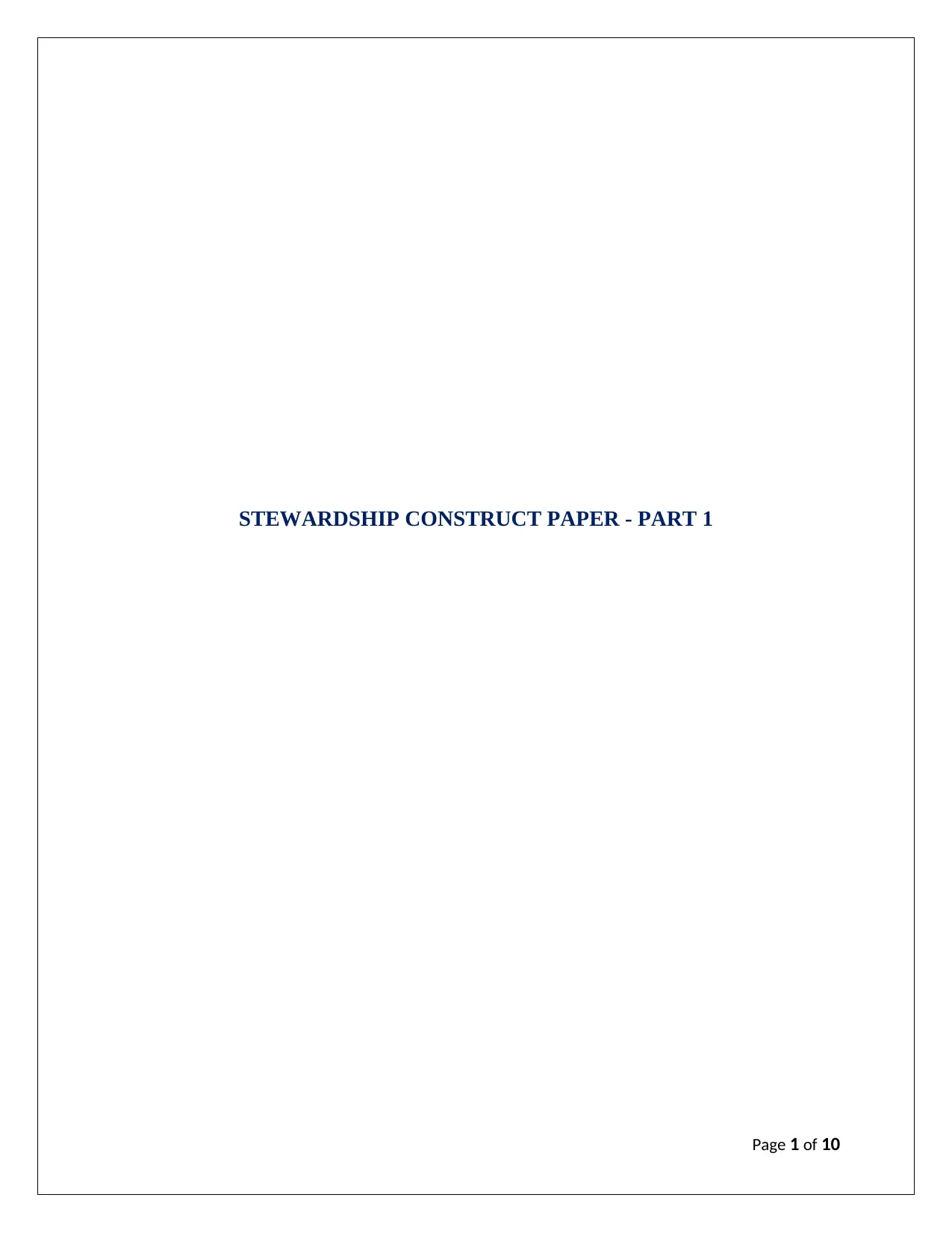
STEWARDSHIP CONSTRUCT PAPER - PART 1
Page 1 of 10
Page 1 of 10
Paraphrase This Document
Need a fresh take? Get an instant paraphrase of this document with our AI Paraphraser
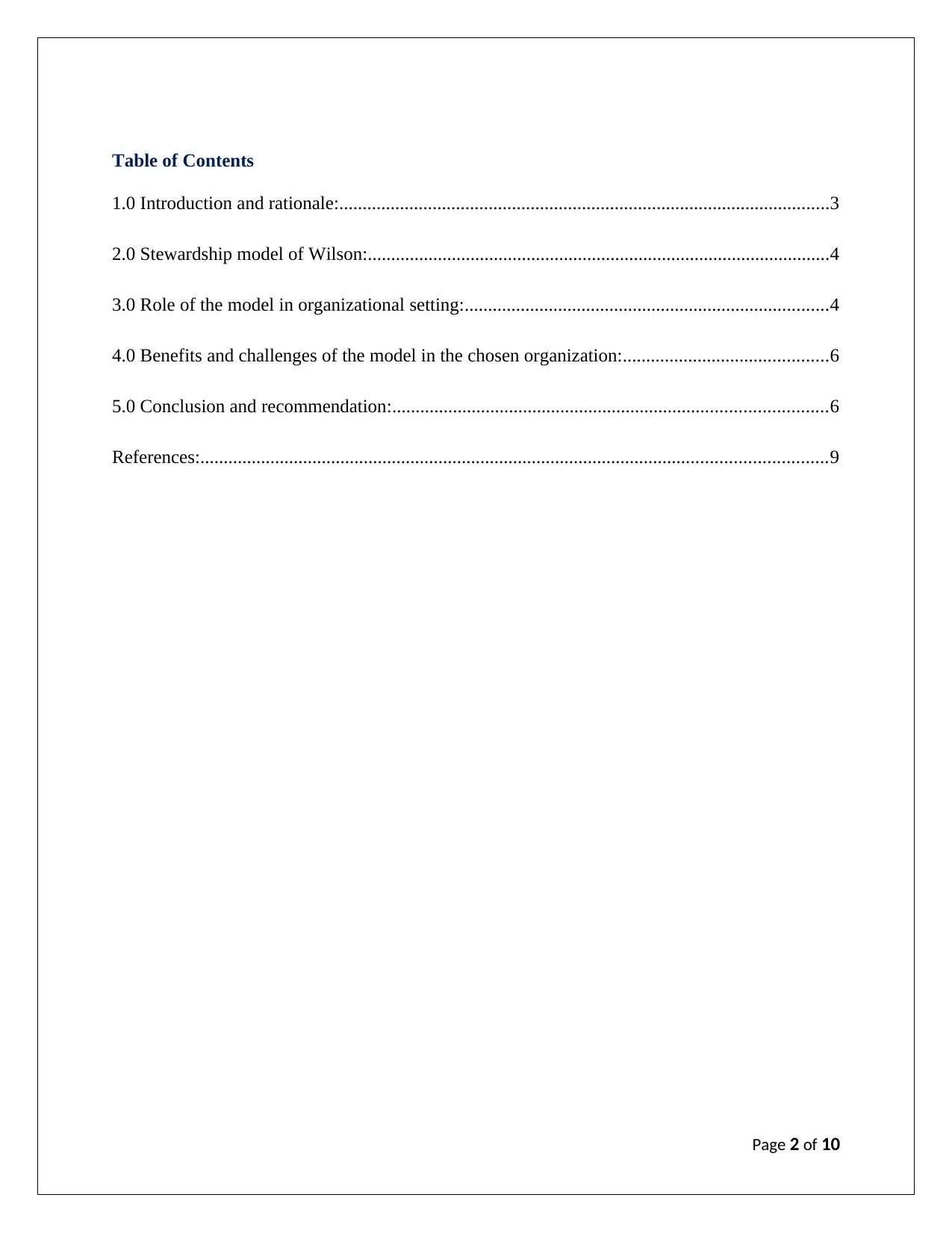
Table of Contents
1.0 Introduction and rationale:.........................................................................................................3
2.0 Stewardship model of Wilson:...................................................................................................4
3.0 Role of the model in organizational setting:..............................................................................4
4.0 Benefits and challenges of the model in the chosen organization:............................................6
5.0 Conclusion and recommendation:.............................................................................................6
References:......................................................................................................................................9
Page 2 of 10
1.0 Introduction and rationale:.........................................................................................................3
2.0 Stewardship model of Wilson:...................................................................................................4
3.0 Role of the model in organizational setting:..............................................................................4
4.0 Benefits and challenges of the model in the chosen organization:............................................6
5.0 Conclusion and recommendation:.............................................................................................6
References:......................................................................................................................................9
Page 2 of 10
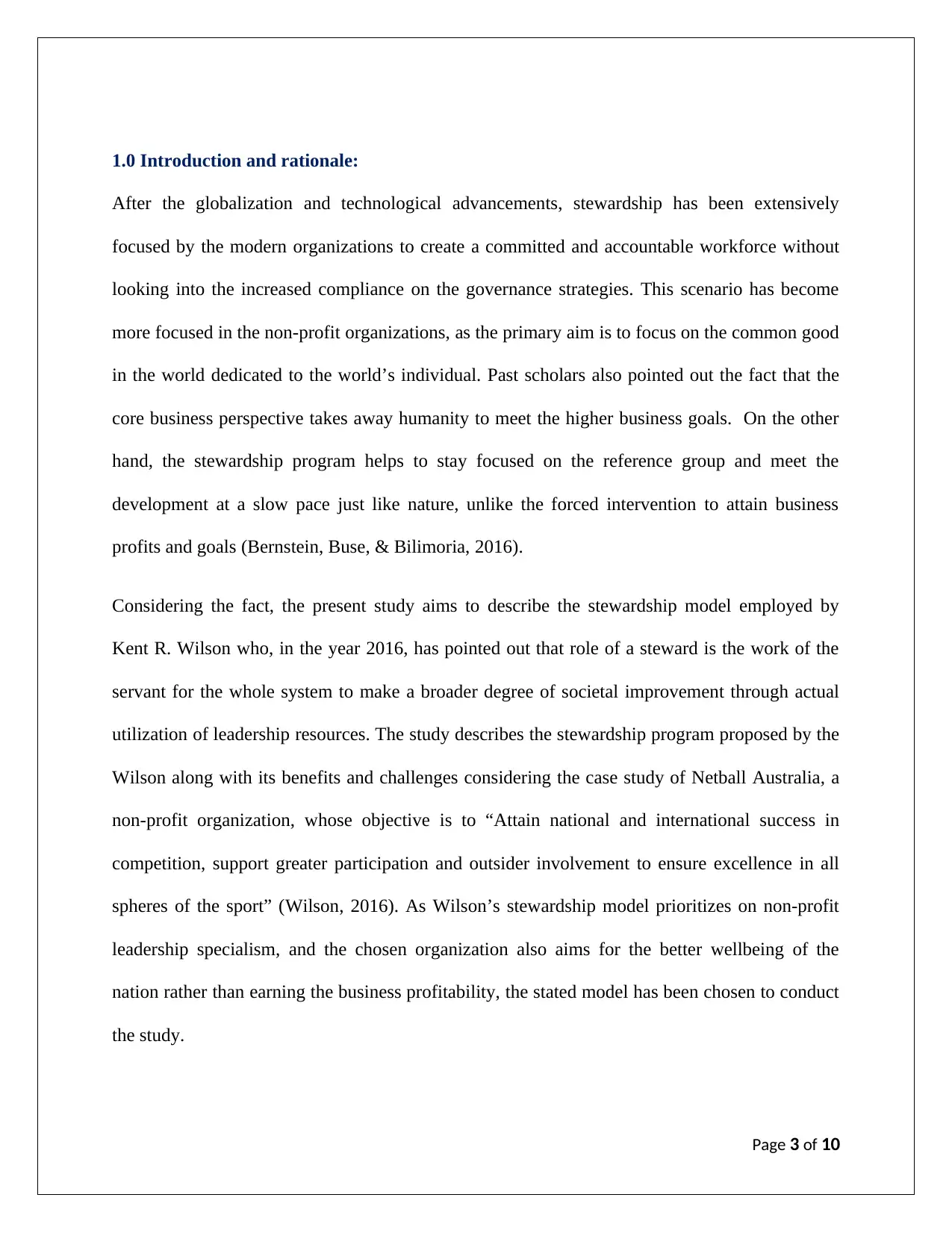
1.0 Introduction and rationale:
After the globalization and technological advancements, stewardship has been extensively
focused by the modern organizations to create a committed and accountable workforce without
looking into the increased compliance on the governance strategies. This scenario has become
more focused in the non-profit organizations, as the primary aim is to focus on the common good
in the world dedicated to the world’s individual. Past scholars also pointed out the fact that the
core business perspective takes away humanity to meet the higher business goals. On the other
hand, the stewardship program helps to stay focused on the reference group and meet the
development at a slow pace just like nature, unlike the forced intervention to attain business
profits and goals (Bernstein, Buse, & Bilimoria, 2016).
Considering the fact, the present study aims to describe the stewardship model employed by
Kent R. Wilson who, in the year 2016, has pointed out that role of a steward is the work of the
servant for the whole system to make a broader degree of societal improvement through actual
utilization of leadership resources. The study describes the stewardship program proposed by the
Wilson along with its benefits and challenges considering the case study of Netball Australia, a
non-profit organization, whose objective is to “Attain national and international success in
competition, support greater participation and outsider involvement to ensure excellence in all
spheres of the sport” (Wilson, 2016). As Wilson’s stewardship model prioritizes on non-profit
leadership specialism, and the chosen organization also aims for the better wellbeing of the
nation rather than earning the business profitability, the stated model has been chosen to conduct
the study.
Page 3 of 10
After the globalization and technological advancements, stewardship has been extensively
focused by the modern organizations to create a committed and accountable workforce without
looking into the increased compliance on the governance strategies. This scenario has become
more focused in the non-profit organizations, as the primary aim is to focus on the common good
in the world dedicated to the world’s individual. Past scholars also pointed out the fact that the
core business perspective takes away humanity to meet the higher business goals. On the other
hand, the stewardship program helps to stay focused on the reference group and meet the
development at a slow pace just like nature, unlike the forced intervention to attain business
profits and goals (Bernstein, Buse, & Bilimoria, 2016).
Considering the fact, the present study aims to describe the stewardship model employed by
Kent R. Wilson who, in the year 2016, has pointed out that role of a steward is the work of the
servant for the whole system to make a broader degree of societal improvement through actual
utilization of leadership resources. The study describes the stewardship program proposed by the
Wilson along with its benefits and challenges considering the case study of Netball Australia, a
non-profit organization, whose objective is to “Attain national and international success in
competition, support greater participation and outsider involvement to ensure excellence in all
spheres of the sport” (Wilson, 2016). As Wilson’s stewardship model prioritizes on non-profit
leadership specialism, and the chosen organization also aims for the better wellbeing of the
nation rather than earning the business profitability, the stated model has been chosen to conduct
the study.
Page 3 of 10
⊘ This is a preview!⊘
Do you want full access?
Subscribe today to unlock all pages.

Trusted by 1+ million students worldwide
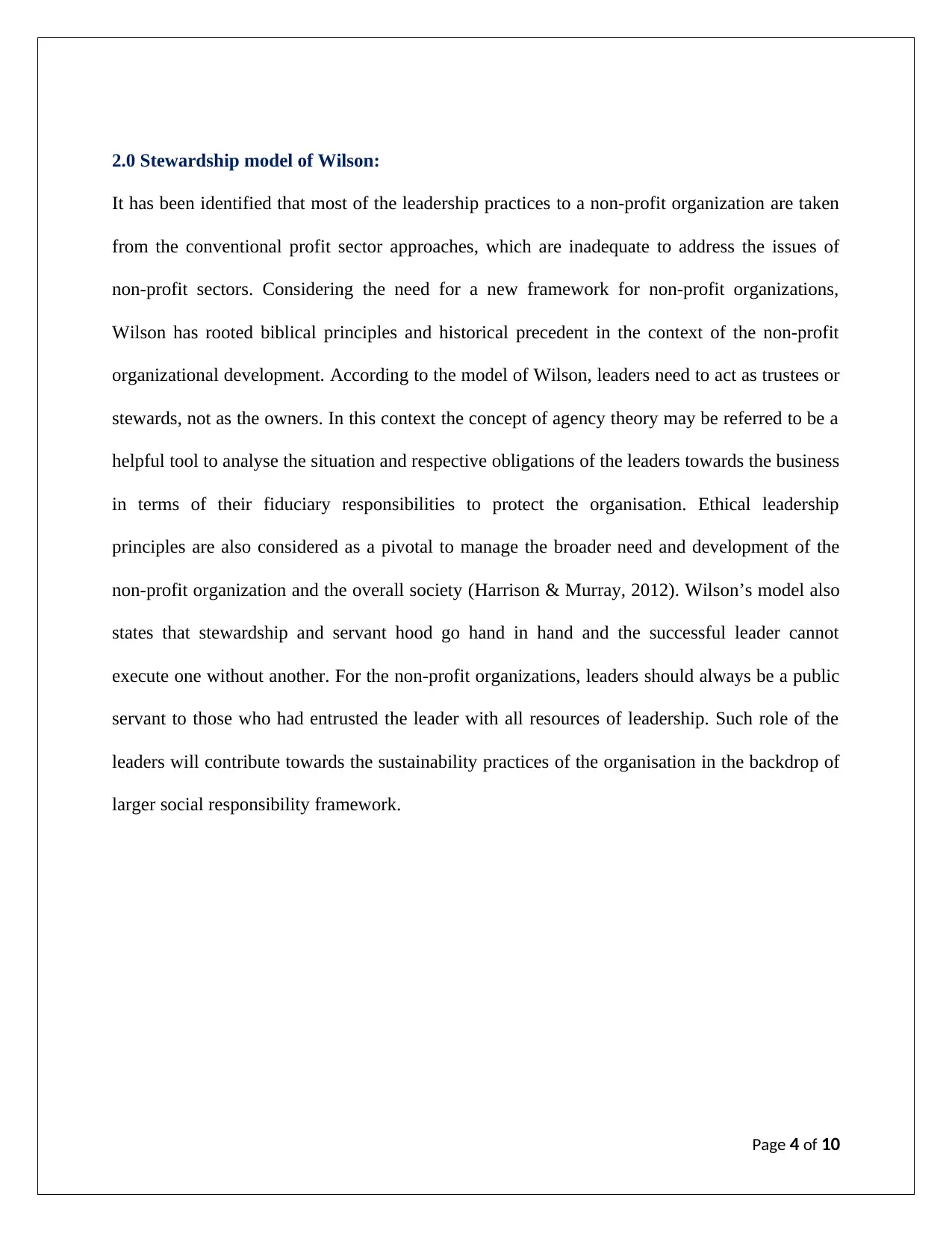
2.0 Stewardship model of Wilson:
It has been identified that most of the leadership practices to a non-profit organization are taken
from the conventional profit sector approaches, which are inadequate to address the issues of
non-profit sectors. Considering the need for a new framework for non-profit organizations,
Wilson has rooted biblical principles and historical precedent in the context of the non-profit
organizational development. According to the model of Wilson, leaders need to act as trustees or
stewards, not as the owners. In this context the concept of agency theory may be referred to be a
helpful tool to analyse the situation and respective obligations of the leaders towards the business
in terms of their fiduciary responsibilities to protect the organisation. Ethical leadership
principles are also considered as a pivotal to manage the broader need and development of the
non-profit organization and the overall society (Harrison & Murray, 2012). Wilson’s model also
states that stewardship and servant hood go hand in hand and the successful leader cannot
execute one without another. For the non-profit organizations, leaders should always be a public
servant to those who had entrusted the leader with all resources of leadership. Such role of the
leaders will contribute towards the sustainability practices of the organisation in the backdrop of
larger social responsibility framework.
Page 4 of 10
It has been identified that most of the leadership practices to a non-profit organization are taken
from the conventional profit sector approaches, which are inadequate to address the issues of
non-profit sectors. Considering the need for a new framework for non-profit organizations,
Wilson has rooted biblical principles and historical precedent in the context of the non-profit
organizational development. According to the model of Wilson, leaders need to act as trustees or
stewards, not as the owners. In this context the concept of agency theory may be referred to be a
helpful tool to analyse the situation and respective obligations of the leaders towards the business
in terms of their fiduciary responsibilities to protect the organisation. Ethical leadership
principles are also considered as a pivotal to manage the broader need and development of the
non-profit organization and the overall society (Harrison & Murray, 2012). Wilson’s model also
states that stewardship and servant hood go hand in hand and the successful leader cannot
execute one without another. For the non-profit organizations, leaders should always be a public
servant to those who had entrusted the leader with all resources of leadership. Such role of the
leaders will contribute towards the sustainability practices of the organisation in the backdrop of
larger social responsibility framework.
Page 4 of 10
Paraphrase This Document
Need a fresh take? Get an instant paraphrase of this document with our AI Paraphraser
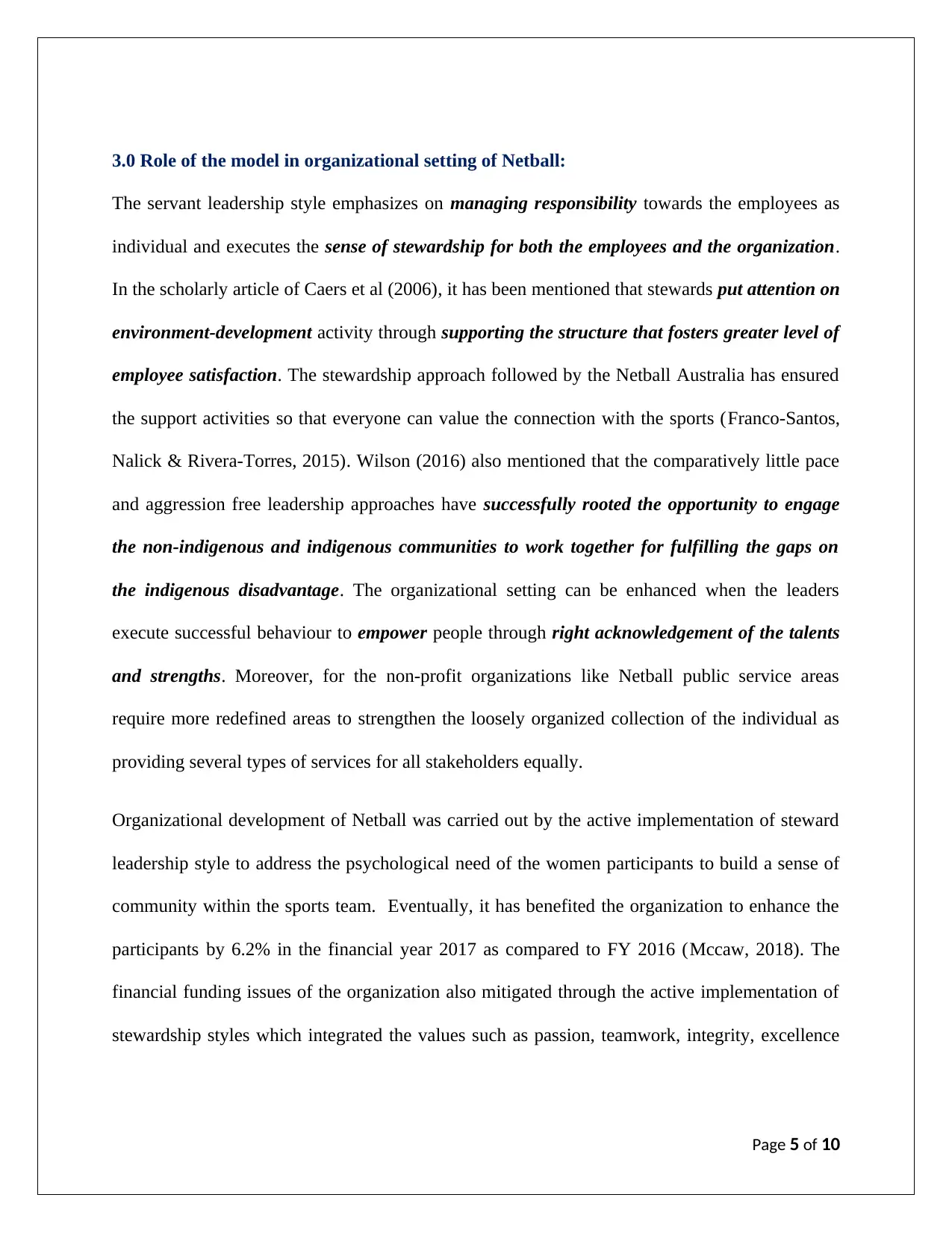
3.0 Role of the model in organizational setting of Netball:
The servant leadership style emphasizes on managing responsibility towards the employees as
individual and executes the sense of stewardship for both the employees and the organization.
In the scholarly article of Caers et al (2006), it has been mentioned that stewards put attention on
environment-development activity through supporting the structure that fosters greater level of
employee satisfaction. The stewardship approach followed by the Netball Australia has ensured
the support activities so that everyone can value the connection with the sports (Franco-Santos,
Nalick & Rivera-Torres, 2015). Wilson (2016) also mentioned that the comparatively little pace
and aggression free leadership approaches have successfully rooted the opportunity to engage
the non-indigenous and indigenous communities to work together for fulfilling the gaps on
the indigenous disadvantage. The organizational setting can be enhanced when the leaders
execute successful behaviour to empower people through right acknowledgement of the talents
and strengths. Moreover, for the non-profit organizations like Netball public service areas
require more redefined areas to strengthen the loosely organized collection of the individual as
providing several types of services for all stakeholders equally.
Organizational development of Netball was carried out by the active implementation of steward
leadership style to address the psychological need of the women participants to build a sense of
community within the sports team. Eventually, it has benefited the organization to enhance the
participants by 6.2% in the financial year 2017 as compared to FY 2016 (Mccaw, 2018). The
financial funding issues of the organization also mitigated through the active implementation of
stewardship styles which integrated the values such as passion, teamwork, integrity, excellence
Page 5 of 10
The servant leadership style emphasizes on managing responsibility towards the employees as
individual and executes the sense of stewardship for both the employees and the organization.
In the scholarly article of Caers et al (2006), it has been mentioned that stewards put attention on
environment-development activity through supporting the structure that fosters greater level of
employee satisfaction. The stewardship approach followed by the Netball Australia has ensured
the support activities so that everyone can value the connection with the sports (Franco-Santos,
Nalick & Rivera-Torres, 2015). Wilson (2016) also mentioned that the comparatively little pace
and aggression free leadership approaches have successfully rooted the opportunity to engage
the non-indigenous and indigenous communities to work together for fulfilling the gaps on
the indigenous disadvantage. The organizational setting can be enhanced when the leaders
execute successful behaviour to empower people through right acknowledgement of the talents
and strengths. Moreover, for the non-profit organizations like Netball public service areas
require more redefined areas to strengthen the loosely organized collection of the individual as
providing several types of services for all stakeholders equally.
Organizational development of Netball was carried out by the active implementation of steward
leadership style to address the psychological need of the women participants to build a sense of
community within the sports team. Eventually, it has benefited the organization to enhance the
participants by 6.2% in the financial year 2017 as compared to FY 2016 (Mccaw, 2018). The
financial funding issues of the organization also mitigated through the active implementation of
stewardship styles which integrated the values such as passion, teamwork, integrity, excellence
Page 5 of 10
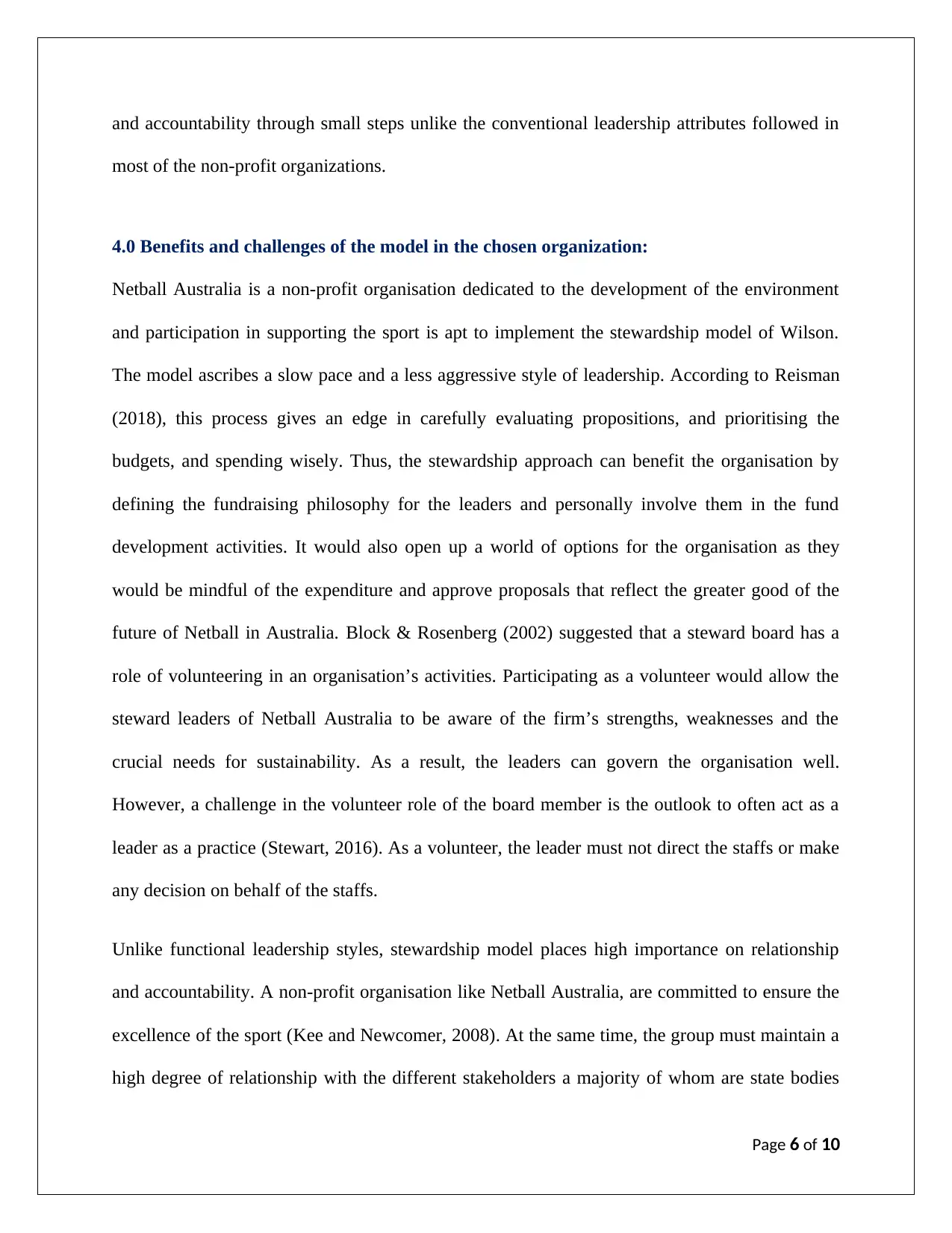
and accountability through small steps unlike the conventional leadership attributes followed in
most of the non-profit organizations.
4.0 Benefits and challenges of the model in the chosen organization:
Netball Australia is a non-profit organisation dedicated to the development of the environment
and participation in supporting the sport is apt to implement the stewardship model of Wilson.
The model ascribes a slow pace and a less aggressive style of leadership. According to Reisman
(2018), this process gives an edge in carefully evaluating propositions, and prioritising the
budgets, and spending wisely. Thus, the stewardship approach can benefit the organisation by
defining the fundraising philosophy for the leaders and personally involve them in the fund
development activities. It would also open up a world of options for the organisation as they
would be mindful of the expenditure and approve proposals that reflect the greater good of the
future of Netball in Australia. Block & Rosenberg (2002) suggested that a steward board has a
role of volunteering in an organisation’s activities. Participating as a volunteer would allow the
steward leaders of Netball Australia to be aware of the firm’s strengths, weaknesses and the
crucial needs for sustainability. As a result, the leaders can govern the organisation well.
However, a challenge in the volunteer role of the board member is the outlook to often act as a
leader as a practice (Stewart, 2016). As a volunteer, the leader must not direct the staffs or make
any decision on behalf of the staffs.
Unlike functional leadership styles, stewardship model places high importance on relationship
and accountability. A non-profit organisation like Netball Australia, are committed to ensure the
excellence of the sport (Kee and Newcomer, 2008). At the same time, the group must maintain a
high degree of relationship with the different stakeholders a majority of whom are state bodies
Page 6 of 10
most of the non-profit organizations.
4.0 Benefits and challenges of the model in the chosen organization:
Netball Australia is a non-profit organisation dedicated to the development of the environment
and participation in supporting the sport is apt to implement the stewardship model of Wilson.
The model ascribes a slow pace and a less aggressive style of leadership. According to Reisman
(2018), this process gives an edge in carefully evaluating propositions, and prioritising the
budgets, and spending wisely. Thus, the stewardship approach can benefit the organisation by
defining the fundraising philosophy for the leaders and personally involve them in the fund
development activities. It would also open up a world of options for the organisation as they
would be mindful of the expenditure and approve proposals that reflect the greater good of the
future of Netball in Australia. Block & Rosenberg (2002) suggested that a steward board has a
role of volunteering in an organisation’s activities. Participating as a volunteer would allow the
steward leaders of Netball Australia to be aware of the firm’s strengths, weaknesses and the
crucial needs for sustainability. As a result, the leaders can govern the organisation well.
However, a challenge in the volunteer role of the board member is the outlook to often act as a
leader as a practice (Stewart, 2016). As a volunteer, the leader must not direct the staffs or make
any decision on behalf of the staffs.
Unlike functional leadership styles, stewardship model places high importance on relationship
and accountability. A non-profit organisation like Netball Australia, are committed to ensure the
excellence of the sport (Kee and Newcomer, 2008). At the same time, the group must maintain a
high degree of relationship with the different stakeholders a majority of whom are state bodies
Page 6 of 10
⊘ This is a preview!⊘
Do you want full access?
Subscribe today to unlock all pages.

Trusted by 1+ million students worldwide
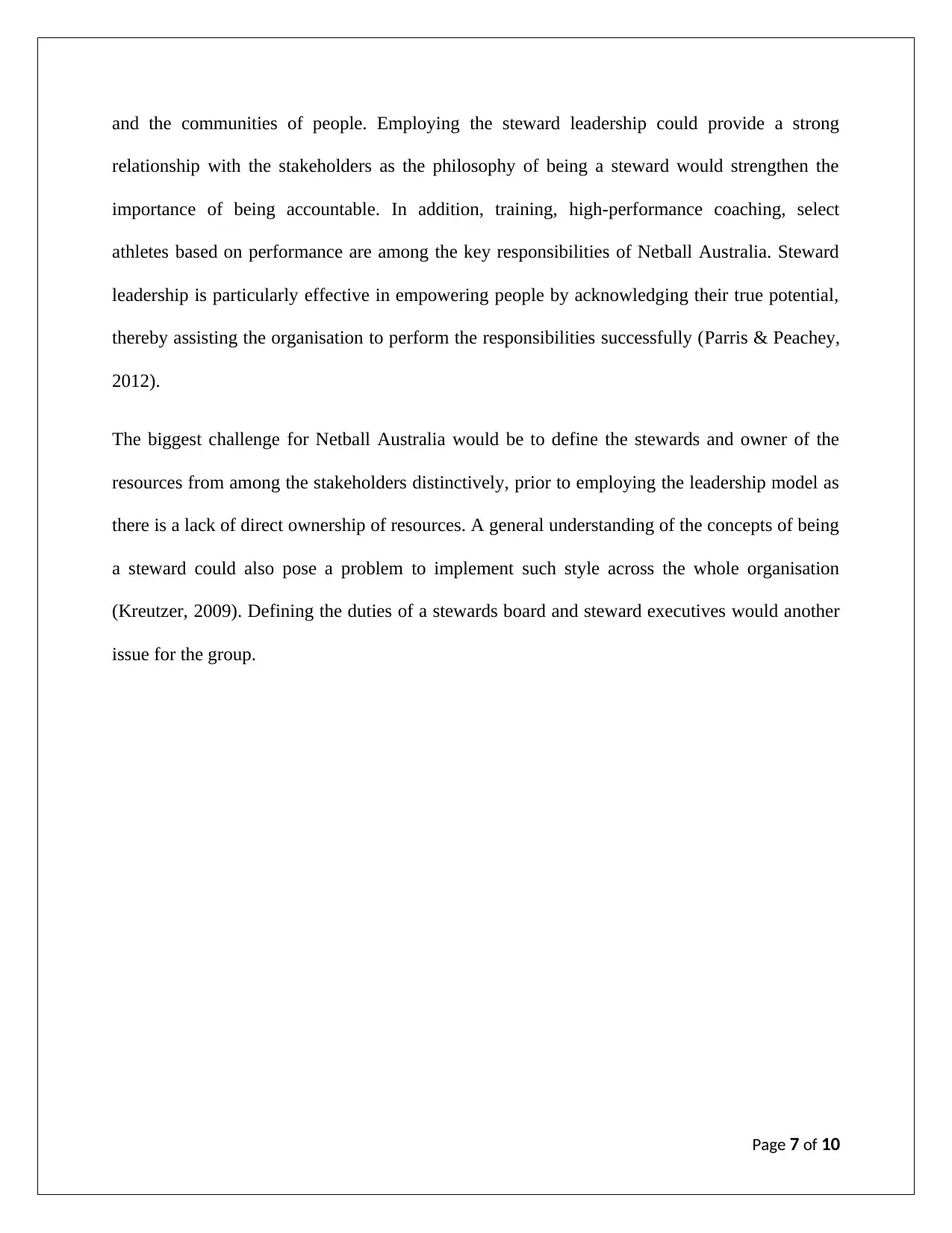
and the communities of people. Employing the steward leadership could provide a strong
relationship with the stakeholders as the philosophy of being a steward would strengthen the
importance of being accountable. In addition, training, high-performance coaching, select
athletes based on performance are among the key responsibilities of Netball Australia. Steward
leadership is particularly effective in empowering people by acknowledging their true potential,
thereby assisting the organisation to perform the responsibilities successfully (Parris & Peachey,
2012).
The biggest challenge for Netball Australia would be to define the stewards and owner of the
resources from among the stakeholders distinctively, prior to employing the leadership model as
there is a lack of direct ownership of resources. A general understanding of the concepts of being
a steward could also pose a problem to implement such style across the whole organisation
(Kreutzer, 2009). Defining the duties of a stewards board and steward executives would another
issue for the group.
Page 7 of 10
relationship with the stakeholders as the philosophy of being a steward would strengthen the
importance of being accountable. In addition, training, high-performance coaching, select
athletes based on performance are among the key responsibilities of Netball Australia. Steward
leadership is particularly effective in empowering people by acknowledging their true potential,
thereby assisting the organisation to perform the responsibilities successfully (Parris & Peachey,
2012).
The biggest challenge for Netball Australia would be to define the stewards and owner of the
resources from among the stakeholders distinctively, prior to employing the leadership model as
there is a lack of direct ownership of resources. A general understanding of the concepts of being
a steward could also pose a problem to implement such style across the whole organisation
(Kreutzer, 2009). Defining the duties of a stewards board and steward executives would another
issue for the group.
Page 7 of 10
Paraphrase This Document
Need a fresh take? Get an instant paraphrase of this document with our AI Paraphraser
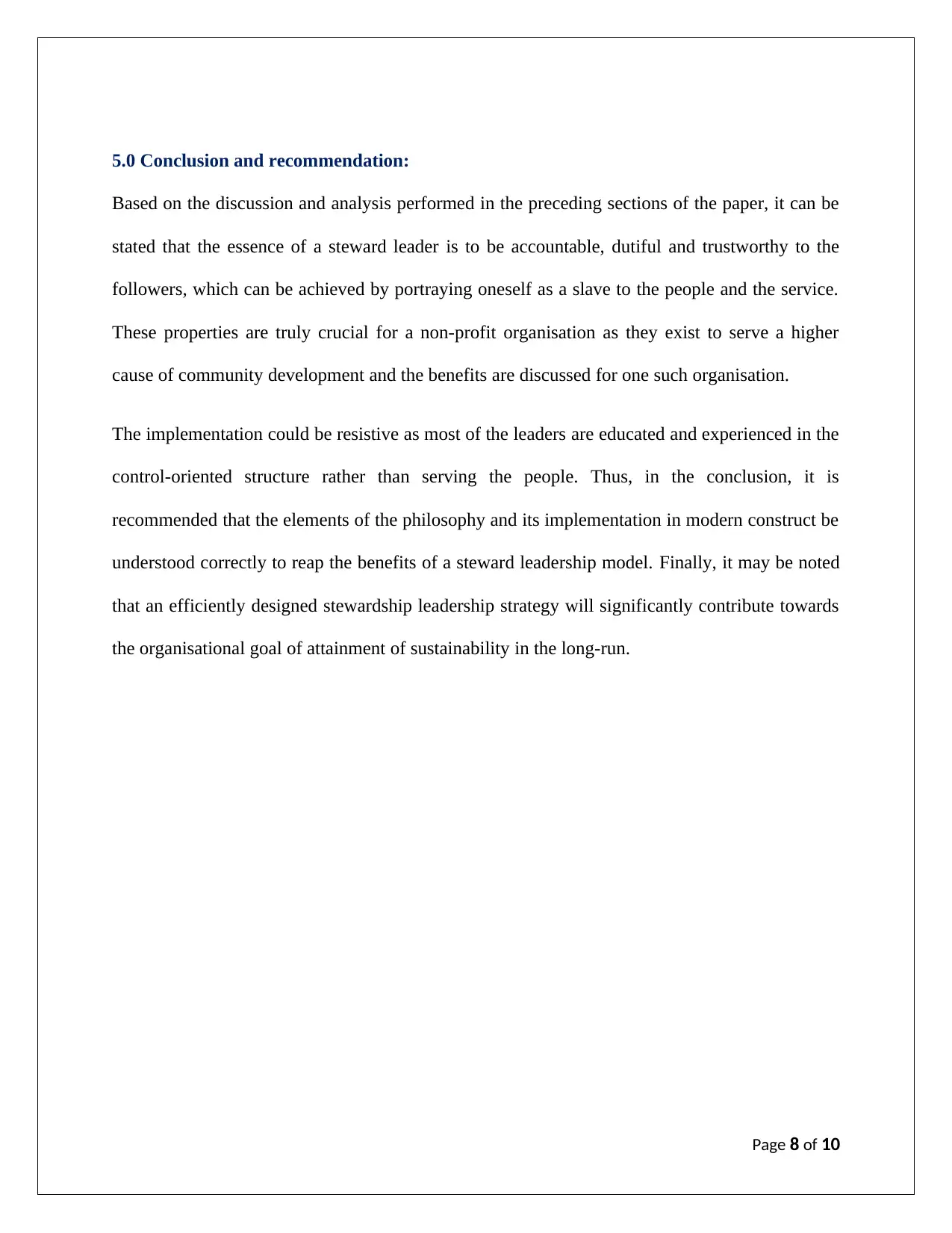
5.0 Conclusion and recommendation:
Based on the discussion and analysis performed in the preceding sections of the paper, it can be
stated that the essence of a steward leader is to be accountable, dutiful and trustworthy to the
followers, which can be achieved by portraying oneself as a slave to the people and the service.
These properties are truly crucial for a non-profit organisation as they exist to serve a higher
cause of community development and the benefits are discussed for one such organisation.
The implementation could be resistive as most of the leaders are educated and experienced in the
control-oriented structure rather than serving the people. Thus, in the conclusion, it is
recommended that the elements of the philosophy and its implementation in modern construct be
understood correctly to reap the benefits of a steward leadership model. Finally, it may be noted
that an efficiently designed stewardship leadership strategy will significantly contribute towards
the organisational goal of attainment of sustainability in the long-run.
Page 8 of 10
Based on the discussion and analysis performed in the preceding sections of the paper, it can be
stated that the essence of a steward leader is to be accountable, dutiful and trustworthy to the
followers, which can be achieved by portraying oneself as a slave to the people and the service.
These properties are truly crucial for a non-profit organisation as they exist to serve a higher
cause of community development and the benefits are discussed for one such organisation.
The implementation could be resistive as most of the leaders are educated and experienced in the
control-oriented structure rather than serving the people. Thus, in the conclusion, it is
recommended that the elements of the philosophy and its implementation in modern construct be
understood correctly to reap the benefits of a steward leadership model. Finally, it may be noted
that an efficiently designed stewardship leadership strategy will significantly contribute towards
the organisational goal of attainment of sustainability in the long-run.
Page 8 of 10
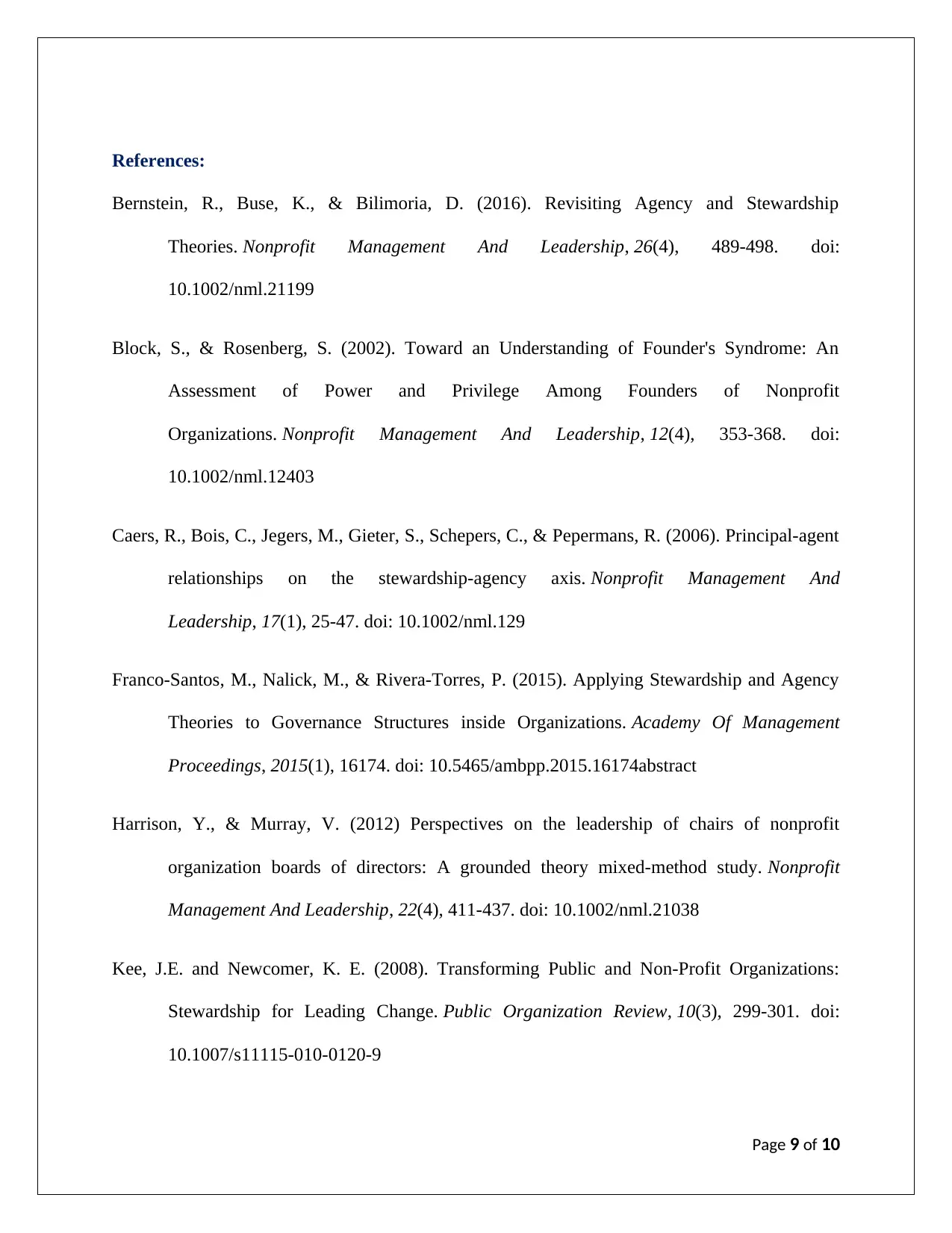
References:
Bernstein, R., Buse, K., & Bilimoria, D. (2016). Revisiting Agency and Stewardship
Theories. Nonprofit Management And Leadership, 26(4), 489-498. doi:
10.1002/nml.21199
Block, S., & Rosenberg, S. (2002). Toward an Understanding of Founder's Syndrome: An
Assessment of Power and Privilege Among Founders of Nonprofit
Organizations. Nonprofit Management And Leadership, 12(4), 353-368. doi:
10.1002/nml.12403
Caers, R., Bois, C., Jegers, M., Gieter, S., Schepers, C., & Pepermans, R. (2006). Principal-agent
relationships on the stewardship-agency axis. Nonprofit Management And
Leadership, 17(1), 25-47. doi: 10.1002/nml.129
Franco-Santos, M., Nalick, M., & Rivera-Torres, P. (2015). Applying Stewardship and Agency
Theories to Governance Structures inside Organizations. Academy Of Management
Proceedings, 2015(1), 16174. doi: 10.5465/ambpp.2015.16174abstract
Harrison, Y., & Murray, V. (2012) Perspectives on the leadership of chairs of nonprofit
organization boards of directors: A grounded theory mixed-method study. Nonprofit
Management And Leadership, 22(4), 411-437. doi: 10.1002/nml.21038
Kee, J.E. and Newcomer, K. E. (2008). Transforming Public and Non-Profit Organizations:
Stewardship for Leading Change. Public Organization Review, 10(3), 299-301. doi:
10.1007/s11115-010-0120-9
Page 9 of 10
Bernstein, R., Buse, K., & Bilimoria, D. (2016). Revisiting Agency and Stewardship
Theories. Nonprofit Management And Leadership, 26(4), 489-498. doi:
10.1002/nml.21199
Block, S., & Rosenberg, S. (2002). Toward an Understanding of Founder's Syndrome: An
Assessment of Power and Privilege Among Founders of Nonprofit
Organizations. Nonprofit Management And Leadership, 12(4), 353-368. doi:
10.1002/nml.12403
Caers, R., Bois, C., Jegers, M., Gieter, S., Schepers, C., & Pepermans, R. (2006). Principal-agent
relationships on the stewardship-agency axis. Nonprofit Management And
Leadership, 17(1), 25-47. doi: 10.1002/nml.129
Franco-Santos, M., Nalick, M., & Rivera-Torres, P. (2015). Applying Stewardship and Agency
Theories to Governance Structures inside Organizations. Academy Of Management
Proceedings, 2015(1), 16174. doi: 10.5465/ambpp.2015.16174abstract
Harrison, Y., & Murray, V. (2012) Perspectives on the leadership of chairs of nonprofit
organization boards of directors: A grounded theory mixed-method study. Nonprofit
Management And Leadership, 22(4), 411-437. doi: 10.1002/nml.21038
Kee, J.E. and Newcomer, K. E. (2008). Transforming Public and Non-Profit Organizations:
Stewardship for Leading Change. Public Organization Review, 10(3), 299-301. doi:
10.1007/s11115-010-0120-9
Page 9 of 10
⊘ This is a preview!⊘
Do you want full access?
Subscribe today to unlock all pages.

Trusted by 1+ million students worldwide
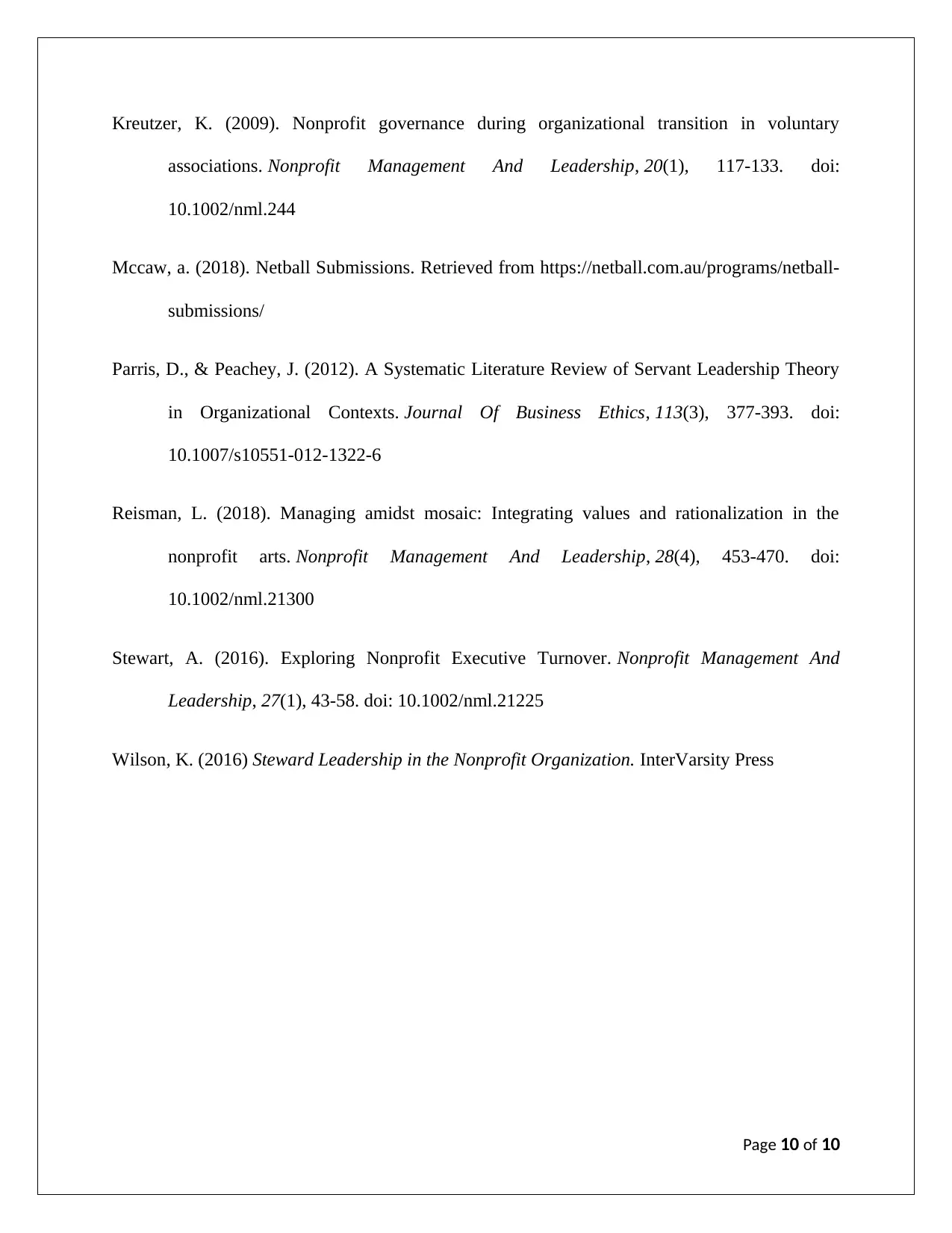
Kreutzer, K. (2009). Nonprofit governance during organizational transition in voluntary
associations. Nonprofit Management And Leadership, 20(1), 117-133. doi:
10.1002/nml.244
Mccaw, a. (2018). Netball Submissions. Retrieved from https://netball.com.au/programs/netball-
submissions/
Parris, D., & Peachey, J. (2012). A Systematic Literature Review of Servant Leadership Theory
in Organizational Contexts. Journal Of Business Ethics, 113(3), 377-393. doi:
10.1007/s10551-012-1322-6
Reisman, L. (2018). Managing amidst mosaic: Integrating values and rationalization in the
nonprofit arts. Nonprofit Management And Leadership, 28(4), 453-470. doi:
10.1002/nml.21300
Stewart, A. (2016). Exploring Nonprofit Executive Turnover. Nonprofit Management And
Leadership, 27(1), 43-58. doi: 10.1002/nml.21225
Wilson, K. (2016) Steward Leadership in the Nonprofit Organization. InterVarsity Press
Page 10 of 10
associations. Nonprofit Management And Leadership, 20(1), 117-133. doi:
10.1002/nml.244
Mccaw, a. (2018). Netball Submissions. Retrieved from https://netball.com.au/programs/netball-
submissions/
Parris, D., & Peachey, J. (2012). A Systematic Literature Review of Servant Leadership Theory
in Organizational Contexts. Journal Of Business Ethics, 113(3), 377-393. doi:
10.1007/s10551-012-1322-6
Reisman, L. (2018). Managing amidst mosaic: Integrating values and rationalization in the
nonprofit arts. Nonprofit Management And Leadership, 28(4), 453-470. doi:
10.1002/nml.21300
Stewart, A. (2016). Exploring Nonprofit Executive Turnover. Nonprofit Management And
Leadership, 27(1), 43-58. doi: 10.1002/nml.21225
Wilson, K. (2016) Steward Leadership in the Nonprofit Organization. InterVarsity Press
Page 10 of 10
1 out of 10
Related Documents
Your All-in-One AI-Powered Toolkit for Academic Success.
+13062052269
info@desklib.com
Available 24*7 on WhatsApp / Email
![[object Object]](/_next/static/media/star-bottom.7253800d.svg)
Unlock your academic potential
Copyright © 2020–2025 A2Z Services. All Rights Reserved. Developed and managed by ZUCOL.





